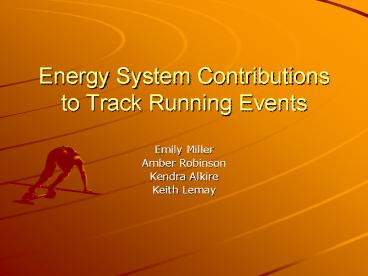Energy System Contributions to Track Running Events - PowerPoint PPT Presentation
1 / 11
Title:
Energy System Contributions to Track Running Events
Description:
Aerobic Respiration in a Photo. Anaerobic and Aerobic Energy System Percent Contribution ... A car's acceleration depends on the gear that the car is in. ... – PowerPoint PPT presentation
Number of Views:17
Avg rating:3.0/5.0
Title: Energy System Contributions to Track Running Events
1
Energy System Contributions to Track Running
Events
- Emily Miller
- Amber Robinson
- Kendra Alkire
- Keith Lemay
2
Our Dilemma
- The figure to the right illustrates the
- relationship between average running
- speed and exercise duration, using a
- logarithmic scale, for mens track
- events. Based on your knowledge of
- cellular ATP synthesis, indicate the
- energy system that is most responsible
- for the ATP yield within muscle cells
- for each component of the graph.
Notice the three phases of the graph. A, B and C.
3
Explanation of the Graph
- Mens track events at the collegiate level go
from 100 meters to 10,000 meters. - These races take from 9 seconds to 36 minutes
respectively. - ATP-CP, Anaerobic and Aerobic energy systems
contribute differing amounts of ATP for
competitors in each race.
4
Early Hypothesis about Energy System Contribution
- Early trials to determine relative energy
contributions resulted in two common
misconceptions. - First, that the energy systems respond to the
demands of intense exercise in an almost
sequential manner, and secondly, that the aerobic
system responds slowly to these energy demands,
thereby playing little role in determining
performance over short durations (Gastin, 2001).
5
Section A
- Stored ATP lasts in the muscle cell for
approximately 3 seconds. - The phosphagen system then responds to the
demand for ATP. - Creatine Phosphate is stored in the muscle
cell. When the muscle demands ATP, the enzyme
Creatine Kinase cleaves off the phosphate from CP
and attaches the phosphate to ADP to make ATP. - Creatine Phosphate stores last for no more
than 10 seconds. - This is the primary energy system used in
the mens 100 meter dash.
6
Section B
- Both aerobic and anaerobic work begin with
glycolysis - (See page 105 in
- text)
- Net for each
- molecule of glucose
- 2 ATP
- 2 NADH
7
Section C
- Aerobic metabolism is the slowest form of
ATP synthesis, however it is the most efficient.
It makes from 30-32 molecules of ATP per glucose. - It begins with the Krebs Cycle, which
doesnt require oxygen. It creates NADH and FADH.
These two carriers contribute electrons to the
Electron Transport Chain. - The Electron Transport Chain Pumps Hydrogen
across the inner mitochondrial membrane to create
a proton gradient. Oxygen is the final electron
acceptor. - H flows down its electrochemical gradient
through a protein complex called ATP Synthase.
ATP Synthase catalyzes the reaction of
ADP P(i) ?gt ATP.
8
Aerobic Respiration in a Photo
9
Anaerobic and Aerobic Energy System Percent
Contribution
10
Our AnalogyShifting to Save Gas
- A cars acceleration depends on the gear that the
car is in. - Performing a California Stop lets you use
stored momentum to accelerate. (Phosphagen
System) - A lower gear means that the car will accelerate
more quickly, but this will take more fuel.
(Anaerobic) - A higher gear will cause less acceleration, but
the fuel efficiency is greater. (Aerobic)
11
References
- Gastin, P. B. (2001). Energy system interaction
and relative contribution during maximal
exercise. Sports Medicine, (31), 725-741. - Silverthorn, D. U., Ober, W. C., Garrison, C. W.,
Silverthorn, A. C. (2007). Human physiology.
San Fransisco Pearson Education. - Alberts, B., Dennis, B., Hopkin, K., Johnson, A.,
Lewis, J., Raff, M., Roberts, K., et al. (2004).
Essential cell biology (2nd ed.). New York, NY
Garland Science. - http//content.answers.com/main/content/wp/en/thum
b/9/92/400px-Etc2.png































